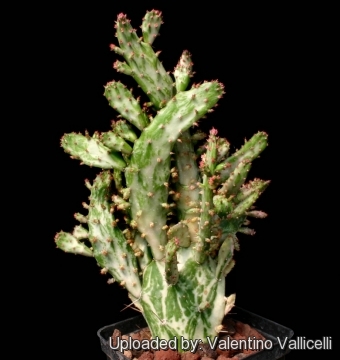Accepted Scientific Name: Opuntia monacantha (Willd.) Haw.
Suppl. Pl. Succ. 81. 1819 [May 1819] Haw.

Opuntia monacantha f. monstruosa variegata Photo by: Valentino Vallicelli
Origin and Habitat: This is one of the very few naturally occurring variegated cacti.
Synonyms:
See all synonyms of Opuntia monacantha
back
Accepted name in llifle Database:Opuntia monacantha (Willd.) Haw.Suppl. Pl. Succ. 81. 1819 [May 1819]Synonymy: 16
Accepted name in llifle Database:Opuntia monacantha subs. brunneogemmia (F.Ritter) P.J.Braun & EstevesSucculenta (Netherlands) 74(3): 133 133 1995.Synonymy: 3
back
Common Names include:
ENGLISH: Dildo, Eltham Indian Fig, Pak'an, Sweet Prickly Pear, Joseph's Coat
Description: Opuntia monacanthaSN|19862]]SN|19862]] f. monstruosa variegata commonly known as “Joseph's Coat” is one of the very few naturally occurring white-variegated cacti. It is a dwarf, teratological variant of the larger Prickly Pear cactus Opuntia monacanthaSN|19862]]SN|19862]]. As its name suggests, this cactus is variegated or marbled with white, creamy-white, yellow, green and sometimes also with pink in varying patterns.
Habit: It is an odd shrubby or tree-like plant that forms wonderfully tortured shapes usually less than 50 cm tall, but occasionally up to 1 m or more metres tall. To many it looks stretched or etiolated due to lack of light, but its actually a monstrous form.
Stem: Long, smooth, flattened beautifully green, yellow and pink covered in tiny hair spines.
Flowers: Small red.
Remarks: In cultivation Opuntia monacanthaSN|19862]]SN|19862]] is perhaps best known in the form of its variety variegata.
Subspecies, varieties, forms and cultivars of plants belonging to the Opuntia monacantha group
 Opuntia monacantha f. monstruosa variegata Photo by: Valentino Vallicelli
Opuntia monacantha f. monstruosa variegata Photo by: Valentino VallicelliSend a photo of this plant.The gallery now contains thousands of pictures, however it is possible to do even more. We are, of course, seeking photos of species not yet shown in the gallery but not only that, we are also looking for better pictures than those already present.
Read More... Cultivation and Propagation: Variegated cacti are regarded as choice and difficult in cultivation, but Opuntia monacanthaSN|19862]]SN|19862]] f. monstruosa is easy to grow on its own roots and very common in cultivation. It is a freely branching species that reproduces readily by cutting, recommended for any collection that needs lots of heat with ample airflow.
Growth rate: It is a fast growing species. It branches profusely from the side and near the tips and can form a 50-100 cm tall shrub in just a few years given the best conditions.
Soils: It likes very porous standard cactus mix soil with more organic matter (peat, humus) than other cacti.
Repotting: Repotting every 2-3 years. It will need a pot with sufficient depth to allow the root to expand. Use pot with good drainage.
Watering: Needs moderate to copious waterings in summer (it is more demanding than other cactus), but do not overwater, keep dry in winter at a minimum temperature of 5°C. Its roots are easily lost in pots that stay damp for any length of time. Keep dry with ample airflow in winter. In the rest period no high atmospheric humidity!! Care must be taken with watering as they tends to become swollen and untidy in growth habit if given too much water and shade.
Fertilization: During the growing season enrich the soil using a fertilizer rich in potassium and phosphorous, but poor in nitrogen, because this chemical element doesn’t help the development of succulent plants, making them too soft and full of water.
Hardiness: It is a tropical plant quite sensitive to frost that need some warmth throughout the year (minimum 5° to 8°C during rest season).
Exposition: Outside filtered sunlight or afternoon shade, but tolerate bright sun too, inside it needs bright light, and some direct sun. Subject to sunburn if exposed to direct sun for too long during the hottest hours in mid summer.
Uses: It is an excellent plant for container growing. It look fine in a cold greenhouse and frame.
Pests & diseases: It may be attractive to a variety of insects, but plants in good condition should be nearly pest-free, particularly if they are grown in a mineral potting-mix, with good exposure and ventilation. Nonetheless, there are several pests to watch for:
- Red spiders: Sensitive to red spider mite. Overhead watering is helpful in controlling mites.
- Mealy bugs: Occasionally mealy bugs they develop aerial into the new growth among the wool with disfiguring results, but the worst types develop underground on the roots and are invisible except by their effects.
- Scales: Scales are rarely a problem.
- Rot: Rot it is only a minor problem with cacti if the plants are watered and “aired” correctly. If they are not, fungicides won't help all that much.
Propagation: Usually cuttings. Cuttings will take root in a minimum temperature of 20° C (but better in hot weather). Cuttings of healthy shoots can be taken in the spring and summer. Cut the stem with a sharp, sterile knife, leave the cutting in a warm, dry place for a week or weeks (depending on how thick the cutting is) until a callus forms over the wound. Once the callus forms, the cutting may be inserted in a container filled with firmed cactus potting mix. The cuttings should root in 2 to 6 weeks.











